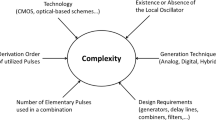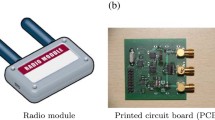Abstract
This paper describes a technique to improve the spectral efficiency and increase the energy in the transmitted pulse of an impulse-radio, ultra-wideband (IR-UWB) transmitter utilizing bi-phase shift keying (BPSK) modulation and working in the frequency range of 3.1–10.6 GHz. Two Gaussian bi-phase pulses are produced and form the base-band signal. These two signals are delayed with respect to each other and are independently up-converted to a different region of the UWB spectrum. The two up-converted signals are then combined to form the final IR-UWB BPSK output signal. The IR-UWB output signal is analyzed in both the time domain and frequency domain to determine time-bandwidth product and spectral efficiency (\(\eta \)). By combining the two up-converted gaussian signals, the spectral efficiency is increased to 77% and the time-bandwidth product of the output signal is 1.7. For a transmitter operating at a data rate of 250 Mbps, the energy per pulse of the output signal can be increased to 4.33 pJ while staying within the FCC spectral and power limits. This technique can also be used to produce a −30 dB notch at 5.9 GHz to further reduce any interference from an IEEE 802.11p Wifi signal.









Similar content being viewed by others
References
IEEE Standard for Information Technology–Telecommunications and Information Exchange Between Systems–Local and Metropolitan Area Networks–Specific Requirement Part 15.4: Wireless Medium Access Control (MAC) and Physical Layer (PHY) Specifications for Low-Rate Wireless Personal Area Networks (WPANs). IEEE Std 802.15.4a, pp. 1–203 (2007).
Yuce, M. R., Keong, H. C., & Chae, M. S. (2009). Wideband communication for implantable and wearable systems. IEEE Transactions on Microwave Theory and Techniques, 57(10), 2597–2604.
Liu, H., Sarrazin, J., Deshours, F., Mavridis, T., Petrillo, L., Liu, Z., et al. (2016). Performance assessment of ir-uwb body area network (ban) based on ieee 802.15.6 standard. IEEE Antennas and Wireless Propagation Letters, 15, 1645–1648.
Decarli, N., Guidi, F., & Dardari, D. (2016). Passive UWB RFID for tag localization: Architectures and design. IEEE Sensors Journal, 16(5), 1385–1397.
Lee, K. K., & Lande, T. S. (2014). A wireless-powered IR-UWB transmitter for long-range passive RFID tags in 90-nm CMOS. IEEE Transactions on Circuits and Systems II, 61(11), 870–874.
Li, J., Zeng, Z., Sun, J., & Liu, F. (2012). Through-wall detection of human being’s movement by UWB radar. IEEE Geoscience and Remote Sensing Letters, 9(6), 1079–1083.
Pittella, E., Pisa, S., & Cavagnaro, M. (2016). Breath activity monitoring with wearable uwb radars: Measurement and analysis of the pulses reflected by the human body. IEEE Transactions on Biomedical Engineering, 63(7), 1447–1454.
Wylie-Green, M. P., Ranta, P. A., & Salokannel, J. (2005). Multi-band OFDM UWB solution for IEEE 802.15.3a WPANs. In Proceedings of IEEE advances in wired and wireless communication (pp. 102–105).
Ganz, F., Puschmann, D., Barnaghi, P., & Carrez, F. (2015). A practical evaluation of information processing and abstraction techniques for the internet of things. IEEE Internet of Things Journal, 2(4), 340–354.
IEEE Standard for Information technology–Local and metropolitan area networks–Specific requirements—Part 11: Wireless LAN Medium Access Control (MAC) and Physical Layer (PHY) Specifications Amendment 6: Wireless Access in Vehicular Environments. IEEE Std 802.11p-2010 (Amendment to IEEE Std 802.11-2007 as amended by IEEE Std 802.11k-2008, IEEE Std 802.11r-2008, IEEE Std 802.11y-2008, IEEE Std 802.11n-2009, and IEEE Std 802.11w-2009), pp. 1–51 (2010).
Wentzloff, D. D. (2007). Pulse-based ultra-wideband transmitters for digital communication. Ph.D. dissertation, Massaachusetts Institute of Technology.
Jones, W. W., & Dill, J. C. (2001). The square root raised cosine wavelet and its relation to the Meyer functions. IEEE Transactions on Signal Processing, 49(1), 248–251.
Chennakeshu, S., & Saulnier, G. J. (1993). Differential detection of \(\pi \)/4-shifted-DQPSK for digital cellular radio. IEEE Transactions on Vehicular Technology, 42(1), 46–57.
Hu, J., Jiang, T., Cui, Z., & Hou, Y. (2008). Design of UWB pulses based on Gaussian pulse. In Proceedings of IEEE nano/micro engineered and molecular systems (pp. 651–655).
Wentzloff, D. D., & Chandrakasan, A. P. (2005). A 3.1–10.6 GHz ultra-wideband Pulse-shaping Mixer. In Proceedings of IEEE radio frequency integrated circuits (RFIC) (pp. 83–86).
Soman, K. P., & Ramachandran, K. I. (2010). Insight into wavelets from theory and practice. New Delhi: PHI Learning.
Bourdel, S., Bachelet, Y., Gaubert, J., Vauche, R., Fourquin, O., Dehaese, N., et al. (2010). A 9-pJ/pulse 1.42-vpp OOK CMOS UWB pulse generator for the 3.1–10.6 GHz FCC band. IEEE Transactions on Microwave Theory and Techniques, 58(1), 65–73.
Hedayati, H., & Entesari, K. (2013). A 90-nm CMOS UWB impulse radio transmitter with 30-dB in-band notch at IEEE 802.11a system. IEEE Transactions on Microwave Theory and Techniques, 61(12), 4220–4232.
Mir-Moghtadaei, S. V., Fotowat-Ahmady, A., Nezhad, A. Z., & Serdijn, W. A. (2014). A 90 nm-cmos IR-UWB BPSK transmitter with spectrum tunability to improve peaceful UWB-narrowband coexistence. IEEE Transactions on Circuits and Systems I, 61(6), 1836–1848.
Pyo, G., Yang, J., Kim, C. Y., & Hong, S. (2016). K-band single-path dual-mode cmos transmitter for FMCW/UWB radar. IEEE Microwave and Wireless Components Letters, 26(10), 858–860.
Author information
Authors and Affiliations
Corresponding author
Additional information
Publisher's Note
Springer Nature remains neutral with regard to jurisdictional claims in published maps and institutional affiliations.
Rights and permissions
About this article
Cite this article
Gunturi, P., Kotecki, D.E. Analysis and Implementation of a Gaussian Addition IR-UWB Transmitter for Increased Spectral Efficiency. Wireless Pers Commun 102, 437–448 (2018). https://doi.org/10.1007/s11277-018-5851-x
Published:
Issue Date:
DOI: https://doi.org/10.1007/s11277-018-5851-x




